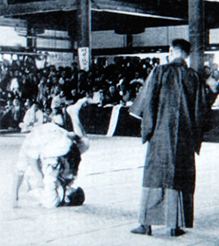AKA Sankaku-Jime | Parent hold Guard (grappling) | |
 | ||
A triangle choke, or sankaku-jime (三角絞) in judo, is a type of figure-four chokehold which strangles the opponent by encircling the opponent's neck and one arm with the legs in a configuration similar to the shape of a triangle. The technique is a type of lateral vascular restraint that constricts the blood flow from the carotid arteries to the brain.
Contents
Technique history
The triangle choke was seen in early kosen judo competition. While details of its origin are unknown, it is strongly associated to Yaichibei Kanemitsu and his apprentice Masaru Hayakawa, who featured the first registered use of the move in a kosen judo tournament in Kobe, Hyogo in November 1921. Earlier names for the technique would have been matsuba-gatame (松葉固め), sankaku-garami (三角緘み) or sankaku-gyaku (三角逆) before finally settling down on sankaku-jime (三角絞め). The sankaku-jime was officially adopted and endorsed by important judokas like Masami Oyama, and soon met plenty of use both in kosen judo and mainstream judo. Tsunetane Oda, a fellow kosen judoka, demonstrated the technique on video and is also credited with the creation of the move in some sources.
The first reported variation was the front triangle choke or mae-sankaku-jime (前三角絞め), applied from the position known in modern times as guard, often after a pull down or hikikomi (引込). Another variation was the horizontal triangle or yoko-sankaku-jime (横三角絞め), performed from the side. Martial arts historian Toshiya Masuda has attributed its innovation to Masahiko Kimura, who would have created it during the Takudai kosen judo tournament at Takushoku University. The inverted variation or ushiro-sankaku-jime (後三角絞め), typically seen in modern judo competition, was the next addition, preceding many others.
Among those variations, the front triangle is particularly favored by practitioners of Brazilian jiu-jitsu. According to a popular belief maintained by Romero Cavalcanti, the technique was introduced in Brazilian jiu-jitsu by Rolls Gracie after finding it in a judo book. Others authors, like Toshiya Masuda and Roberto Pedreira, believe it might have been introduced in Brazil much before by Yasuichi and Naoichi Ono, disciples of Yaichibei Kanemitsu, as well as possibly other judo practitioners like Ryuzo Ogawa. Rolls's trainee Mario Tallarico lends credibility to this theory.
The triangle choke was first shown in mixed martial arts on December 16, 1994, when Royce Gracie used a front triangle to defeat Dan Severn and win the UFC 4 tournament. This variation has remained as the most commonly seen in MMA, although the side or inverted triangle has been also used; on September 26, 1995, Shooto fighter Rumina Sato submitted Isamu Osugi with a flying inverted triangle choke, while many years later, Toby Imada won 2009 Submission of the Year with an inverted triangle choke over Jorge Masvidal. Even more complex holds, like Chris Lytle's inverted mounted triangle/straight armbar combination at UFC 116 in 2010, have also surfaced.
Technique
Tactically speaking, the triangle choke is a very effective counterattack employed from the bottom position, generally applied from the guard, or open guard (defensive positions). The choke can also be applied in the mount, side mount and back mount positions by more advanced grappling practitioners. The need for isolation of one arm could be a rationale for the frequency with which it is attempted in mixed martial arts and combat sports due to the brief vulnerability of one arm while executing hand strikes against an opponent in one of the aforementioned positions.
Defensive Action
To escape a triangle choke, the defending practitioner must first elevate the head so as the preclude the full force of the submission, subsequently the practitioner must bring his arm away from opposition with his own carotid artery. Once out of immediate danger of loss of consciousness, the practitioner can concentrate reversing or escaping the figure-four lock.
In popular media
In the film Lethal Weapon, Mel Gibson's character Martin Riggs uses the triangle choke on a villain Mr. Joshua played by actor Gary Busey. Rorion Gracie is credited as the film’s special technical advisor: Brazilian jiu-jitsu. In the film Abduction, Taylor Lautner's character uses the triangle choke on an antagonist. In the film Haywire, Gina Carano's character uses the triangle choke on Michael Fassbender's character. During a school fight in the anime Ikki Tousen, the character Ryomou Shimei uses the triangle choke on another character, Hakufu. In the 2013 film Oblivion, Tom Cruise's character (Tech 49, Jack Harper) subdues Tech 52 with a triangle choke, to avoid injuring him. Paul Walker, who was a practitioner of Brazilian Ju Jitsu, attempted to triangle Vin Diesel's character in the Fast and Furious series. In episode 5 of Game of Thrones: A Telltale Game Series, a pit fighter named 'Bloodsong' uses this technique while on supine position to choke Asher, one of the 5 playable protagonists in the game. In episode 3 of the God Eater anime, Alisa Illinichina Amiella uses the triangle choke on Lenka Utsugi, the main protagonist.
